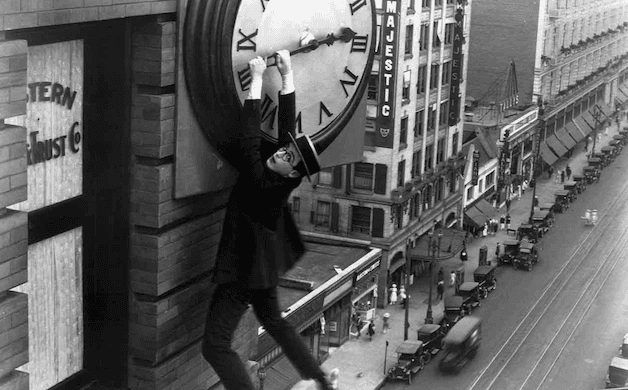Harold Lloyd Retrospective Offers a Chance for Reassessment
Although his name appears in the credits primarily as an actor, Lloyd was a firm presence behind the camera and, I would argue, among the finest of comedy directors.

The sacrifices we make for those close to us. Cajoled by the daughter of a friend, I agreed to watch “Top Gun: Maverick,” the movie Steven Spielberg claimed “saved Hollywood’s ass.” I don’t know about Hollywood, but my behind was markedly discomfited during the run of the picture. Not because high-end, machine-tooled products aren’t to my taste, but because I was reminded of Harold Lloyd.
Or, rather, of a not altogether flattering comparison between Tom Cruise and Lloyd made by the film historian and critic David Thomson. The commonalities he sighted included “the slight figure. The shock of dark hair. The inner numbness wiped away by the terrific friendly grin and … the innocent yet determined notion of getting ahead and being a success.” All of which made “Top Gun: Maverick” even harder to bear.
Film Forum is mounting a retrospective of Lloyd films in honor of the 100th anniversary of “Safety Last,” the “thrill picture” that contains among the most iconic moments in the history of cinema: Lloyd’s “glasses” character hanging, at a dizzying height, from the hands of a large clock over a Los Angeles street. Even the most cursory movie fan knows the image, if not from direct contact with the picture itself then from a kind of broader cultural osmosis.
Over the course of nine weekends beginning April 1, Film Forum will be showing Lloyd’s greatest hits or, at least, the majority of his features made during the 1920s. New Yorkers will want to pay special attention to “Speedy” (1928), in which Lloyd, as the title character, strives mightily to save the last independent rail line in Manhattan. The bigger part of the picture was filmed not on a Hollywood backlot, but on site at New York City. An accompanying short feature, “In the Footsteps of Speedy,” revisits those locations to fascinating effect. All of the films will feature live piano accompaniment by Steve Sterner.
Running the entirety of the erstwhile comedian’s oeuvre — it numbers around 200 movies — would prove taxing to even the most gung-ho comedy nerd. Lloyd made dozens of short films playing an inverted Chaplin knock-off dubbed Lonesome Luke before donning the trademark horn-rimmed glasses. If the spectacles hadn’t come, Lloyd would, in all likelihood, have been consigned to the gallery of run-of-the-mill grotesques that typify silent screen comedy.
As a result of the shift, Lloyd’s screen persona took a distinct step toward naturalism and, with it, empathy. His can-do demeanor is part-and-parcel of the Jazz Age — a distinctly American phenomenon marked by optimism, prosperity, and cultural dynamism. While the 1920s were, in fact, roaring, Lloyd’s star was ascendant and the films remarkably consistent in quality. Lloyd’s command of the medium increased along with his popularity. He was a greater draw for audiences than Charlie Chaplin and Buster Keaton.
Lloyd had an active hand in how his movies were shaped. Although his name appears in the credits primarily as an actor, he was a firm presence behind the camera and, I would argue, among the finest of comedy directors. Forget, for instance, Lloyd’s famed climb up the side of a building in “Safety Last.” Pay attention, instead, to the opening scene, a play on audience expectations that is surefire as a gag and, in its elision between the real and the imagined, profoundly cinematic. The final scene, as well, achieves a kind of poetry notwithstanding its throwaway nature.
The standard line on Lloyd is that he’s a learned talent as opposed to Chaplin and Keaton, who were geniuses. There’s some truth to this: Lloyd was a workhorse, Chaplin and Keaton sui generis. Yet I suspect that Lloyd is given short shrift less because of his skill as a filmmaker than for the everyman character he embodied.
Most of the classic movie comedians — Chaplin, Keaton, Laurel and Hardy, the Marx Brothers, and W.C. Fields — operated in a world to which they were, if not out-and-out hostile, then decidedly outsiders. Lloyd, in contrast, was an accommodationist, an outsider who wanted “in.” In a culture that places a premium on perpetual rebellion, nice guys may make it to the top of the De Vore Department Store unscathed, but they don’t necessarily flourish in the public imagination or amongst high-minded cineastes.
As it is, Harold’s conformist nature isn’t as cut-and-dried or, pace Mr. Thomson, “inwardly numbed” as you might think. Lloyd was a consummate actor — for a master class in registering emotion, watch his increasing awareness of Jobyna Ralston’s affection in “Why Worry?” (1923) — as well as given to moments of social justice initiative. (He’s avowedly anti-capitalist in “Speedy.”)
That, and Lloyd is the first person to flip the bird on screen. There are, of course, better reasons to treasure his work, as will become readily apparent to those wise enough to attend Film Forum’s most welcome retrospective.

